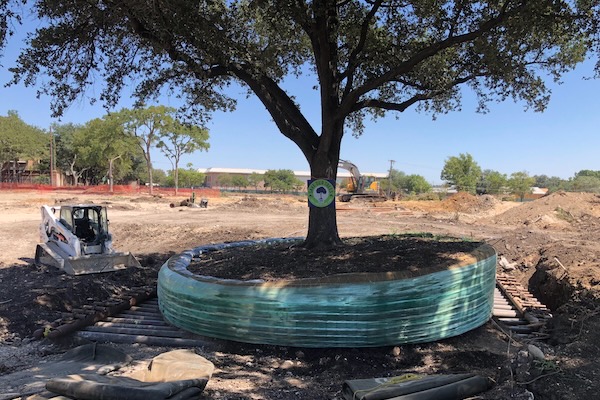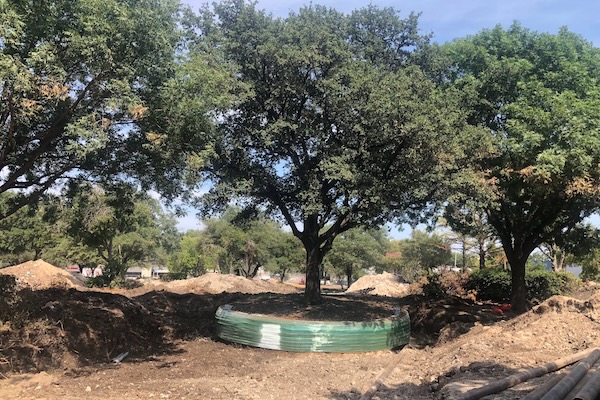
A Houston-based company was enlisted to move four mature oaks out of the way of an Addison development. Photo courtesy of Environmental Design.
Sept. 8, 2023
Four large live oaks in the path of development have a new home in an Addison park.
The roughly 60-year-old trees were relocated last month by AMLI, a Chicago-based developer, which is building a 14-acre mixed-used development at 14675 Midway Road in Addison.
The residential community called Tree House will include 370 apartments within its main building, 35 apartments in a senior-friendly building, 14 rental townhouses, 30 for-sale townhouses, unique live/work residences and 7,000 square feet of retail.
AMLI's commitment to sustainable building practices dates back to 2008 when it pledged to design all future developments to achieve LEED certification through the U.S. Green Building Council. The developer is aiming for LEED Silver certification on the project.
“We’ve been trying to do the right thing before sustainability was cool,” said Taylor Bowen, president of AMLI Development Company. “In this case, we also had an opportunity to save these magnificent live oaks.”
TREE MOVERS
Environmental Design, a Houston-based company, which specializes in moving heritage trees, was enlisted to relocate the decades old oaks in Addison.
Jon Hillis, vice president of Environmental Design, said the company helped select the four trees that were saved for their attractive shape and size.
 A live oak in Addison is prepared for relocation. Photo courtesy of Environmental Design.
A live oak in Addison is prepared for relocation. Photo courtesy of Environmental Design.
According to Hillis, Environmental Design moves trees all over the world, using a patented technology called ArborLift. The company can move root balls more than 36 feet in diameter with weights exceeding one million pounds.
Hillis said memorable projects include relocating a 1,000-year-old Sycamore Fig in Jerusleum to make way for road construction; procuring trees for the 911 Memorial in New York City; and replacing an iconic tree on Pebble Beach Golf Links in California.
At Pebble Beach, the pine on the 18th hole had succumbed to pine pitch canker. The tree was central to the challenge of the world-famous finishing hole. Replacing the giant with a smaller sapling wouldn’t do. So Environmental Design relocated a 200-year-old Monterey Cypress, a more hardy species, from the first tee and to final green. It took more than five hours to make the one-plus-mile trek.
Hillis said universities are another steady source of business and they’ve moved historic trees on the campuses of the University of Texas, Texas A&M, Purdue and Stanford.
READY TO ROLL
The process of moving trees begins months ahead of the physical relocation. Staff may prune roots, apply fertilizer or insecticide and start a watering schedule to help prepare the tree for the shock of relocation.
“In Addison, we got started on these trees three months in advance,” Hillis said.
A video shows Environmental Design's patented tree moving process called ArborLift.
A moat is dug around each tree. How far down they dig, depends on the individual tree and the species.
“With live oaks and most hardwoods, the vital root system is located in the top 26 inches,” he said. “We go down four feet with most of these trees. Pecans and pine trees have tap roots. For them we have to go as deep as six feet.”
The key to successfully moving a tree is maximizing the size of the root ball, Hillis said. The tree’s diameter is measured and multiplied by 10 to calculate the span.
A 24-inch caliper tree would have a 240-inch or 20-foot root ball.
Once the moat is dug, pipes are hammered in horizonitally, under the tree’s root ball. The pipes hold the root ball in place as trenches are dug under the pipes. Then air bladders are inserted in the trenches and inflated. The tree is then rolled to its destination with the air bags acting like logs.
“As they roll along, the bags pop out the back and are moved to the front,” he said.
The tree is lowered into a prepared hole, which is backfilled and mulched. Supplements may be added to stimulate root growth. Then months of aftercare begin. The tree will be watered regularly and monitored for three to five years.
“We don’t take shortcuts. We’ve got a perishable product,” said Hillis. “It has to be successful long term. As many as 98 percent of our large tree moves are successful, if not more.”
 The live oaks that were relocated were selected for their attractive canopies. Photo courtesy of Environmental Design.
The live oaks that were relocated were selected for their attractive canopies. Photo courtesy of Environmental Design.
PARK EXPANSION
As part of AMLI’s agreement with the city of Addison, in addition to relocating the live oaks, the company is planting 350 new trees to replace trees that were felled. The developer is also donating three acres to the city to extend the Redding walking trail and park, which is located adjacent to the property.
The four live oaks were moved as far as 450 feet to the linear park, which will be owned and managed by the city.
“This is going to beautify this little park,” said Bowen. “It’s something that’s going to make this development better.”
While these trees and others were spared, more than 300 trees were cleared, along with existing office buildings, in preparation to start construction next year.
“Unfortunately a lot of the trees hadn’t been taken care of properly over the years,” Bowen said. “Many of them were built too close to buildings and were one-sided. They didn’t have the right kind of canopy. It limited the ones we could save.”
Still, Hillis commended AMLI for going above and beyond to save, what he says were the best specimens.
“I’m applauding them,” said Hillis. “These trees that we’re moving on these sites are irreplaceable. It’s so important to preserve these heritage trees into design.”
RELATED ARTICLES
Trees need watering during Texas drought
Big trees need more protection, say DFW advocates
Climate change is affecting Texas native plants, says prof
Stay up to date on everything green in North Texas, including the latest news and events! Sign up for the weekly Green Source DFW Newsletter! Follow us on Facebook,Twitter and Instagram. Also check out our podcast The Texas Green Report, available on your favorite podcast app.









